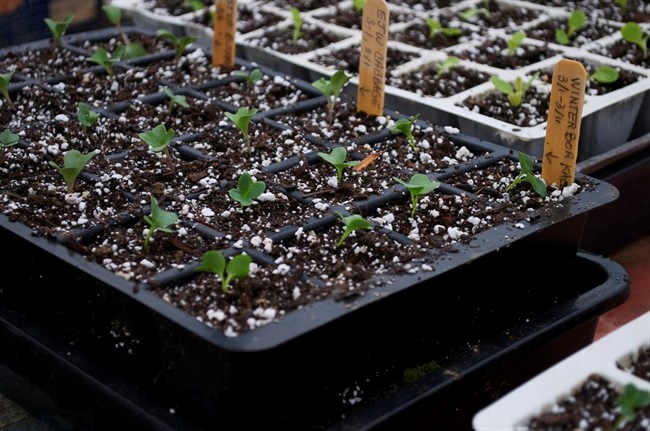Ready. Set. Go. Growing seedlings indoors seems almost like a race. Of course, it has a staggered start, with onions already growing strongly and tomatoes not yet sown.
Watering these seedlings is crucial: Timely watering keeps them chugging along apace; two or three days of neglect could spell death.
A simple way to automatically water seedlings is to rely on the soil to draw water up from below by capillary action. This is just how various types of commercially available seedling-growing kits work (available online from such sites as gardeners.com, leevalley.com, burpee.com and charleysgreenhouse.com).
Soil watered by capillary action stays constantly moist, rather than swinging between the extremes of having plant roots cry out for air and then for water.
LET CAPILLARITY WORK FOR YOU
Capillary watering itself is nothing new. For years, capillary matting — a thick, water-absorbent fabric that does not rot — has been available, mostly to commercial greenhouse growers. The idea is to let one end of the fabric dip down into a water reservoir while the remainder rests flat on a horizontal surface. Pots of plants sit on the flat mat. If the pots likewise have flat bottoms and the soil within is right up against the bottom of the pots, then a capillary water connection is established throughout. As plants drink in water, it is replenished by water drawn up from the mat which is, in turn, drawn up from the reservoir.
These capillary-watering seed starters are nifty setups that make it convenient to raise seedlings in your home. A small plastic pan holds water. Into the pan fits a Styrofoam or plastic "table" on which sits the mat, with one end dipping into the water. A multi-celled Styrofoam or plastic planting tray sits atop the mat.
The whole setup is about the size of a three-ring notebook, or half that, depending on the number and size of the cells. Right now, my broccoli, Brussels sprouts, cabbage and kale seedlings — 24 seedlings in about a square foot of space — are growing in 1-1/2 inch square cells. In about a month, I'll have cucumbers and melons started in propagators with slightly larger cells.
A few other features round out these systems. A clear plastic cover maintains humidity while seeds are germinating, then tucks neatly out of the way under the reservoir. The underside of the "table" looks like a pegboard, and can be flipped over to pop seedlings up out of their cells when they are ready for transplanting. Plant roots knit the soil together to keep it intact during transplanting. And after a good cleaning, the whole setup is ready for re-use year after year.
A FEW CAUTIONARY NOTES
Capillary watering does have drawbacks. Water evaporating at the surface of the soil leaves fertilizer salt residues. These residues can accumulate in the soil and draw water out of the roots the same way potato chips dry out your lips. Seedlings generally do not spend enough time in containers to bring on this problem, especially when care is taken not to over-fertilize. If necessary, occasional watering from above will wash the salts down and out of the soil.
Another problem is that of seedling roots growing out through the bottom of their cells and into the matting. Then plants become difficult to remove from their cells and lose too many roots when they are finally ripped away. I avert this problem by periodically lifting the planting tray up off the mat beginning when the seedlings are large enough for their roots to bind the soil together.
Perhaps the worst threat to any automated system is neglect. I have almost lost seedlings from forgetting to check the water level in the reservoir, which only needs to be done about weekly. It's easy to forget about watering when so much of the job is done for you.
Despite these minor shortcomings, these capillary watering systems for raising seedlings are among the few horticultural gizmos that I recommend. Before I used them, my seedlings tethered me to my house daily throughout April and May.
___
Online:
http://leereich.blogspot.com/
http://leereich.com/



